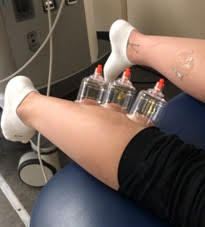
Dave Hammons, director of athletic training and associate professor in the School of Allied Health Sciences’ Department of Kinesiology, and alum Molly McCullough (‘20) published “The Effect of Dry Cupping on Gastrocnemius Muscle Stiffness, Range of Motion and Pain Perception After Delayed Onset Muscle Soreness” in the October 2022 edition of Alternative Therapies in Health and Medicine.

The study of 20 healthy, physically active young adults assessed changes in the perception of pain and range of motion after a cupping treatment in patients with delayed onset muscle soreness. Cupping is an ancient practice, viewed as a complementary therapy in the United States, in which cup-shaped objects are placed over the impacted part of the body and the skin is lifted via suction. Over millennia, cupping has been used to treat multiple conditions, including pain and injuries.
The practice has gained favor and attention in recent years as Olympians and other elite-level athletes have taken it up, but there has been little rigorous scientific examination of how or why it works.
The Boise State study, part of McCullough’s graduate work and thesis in 2019, meant to build on the body of research to date.
“It’s a good example of students and faculty doing collaborative research projects that are especially important to the clinician,” Hammons said.
Hammons and McCullough wanted to know whether cupping reduced muscle stiffness; the stiffness would correlate with pain, which is often the reason cupping is used. They induced soreness through exercise, then used ultrasound to measure elasticity, or the level of stiffness, in participants’ calf muscles before and after a single cupping treatment.
Compared to the control group, they found that the perception of pain was reduced, but that it was not necessarily due to a reduction in muscle stiffness, and found a statistical difference in the group that did cupping and the improvement in range of motion that resulted. Their hypothesis? Pain stimuli were overridden in the peripheral nervous system by the stimuli created due to the mechanical pressure changes caused by cupping.
“These findings are valuable,” Hammons said, noting that given the paucity of rigorous study, cupping often is applied based on word of mouth and anecdotal reports. “Our point is to try to find out why, so that we’re not using these treatments blindly.”